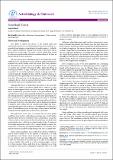Files in this item
Snowball Earth
Item metadata
| dc.contributor.author | Banik, Indranil | |
| dc.date.accessioned | 2016-09-15T11:30:19Z | |
| dc.date.available | 2016-09-15T11:30:19Z | |
| dc.date.issued | 2016-08-25 | |
| dc.identifier | 245838050 | |
| dc.identifier | 7530a608-97b6-4d15-8043-28b501014e58 | |
| dc.identifier.citation | Banik , I 2016 , ' Snowball Earth ' , Journal of Astrobiology & Outreach , vol. 4 , no. 2 , 153 . https://doi.org/10.4172/2332-2519.1000153 | en |
| dc.identifier.issn | 2332-2519 | |
| dc.identifier.other | ORCID: /0000-0002-4123-7325/work/29616902 | |
| dc.identifier.uri | https://hdl.handle.net/10023/9508 | |
| dc.description.abstract | In the ongoing quest to better understand where life may exist elsewhere in the Universe, important lessons may be gained from our own planet. In particular, much can be learned from planetary glaciation events that Earth suffered ∼600 million years ago, so-called `Snowball Earth' episodes. I begin with an overview of how the climate works. This helps to explain how the ice-albedo feedback effect can destabilise a planet's climate. The process relies on lower temperatures causing more ice to form. Ice being very reflective, the climate is cooled further, forming yet more ice. This instability rarely causes a runaway planetary glaciation because of an important stabilising mechanism — the carbonate-silicate cycle (weathering feedback). Lower temperatures lead to less rainfall and weathering of surface rocks, reducing the rate at which carbon dioxide (CO2) is removed from the atmosphere. Continued emission from volcanism leads to its atmospheric levels building up, enhancing the greenhouse effect. This shows the necessity of geologic activity on a habitable world. Next, I review some of the evidence that Earth really did suffer a planetary glaciation, and most likely several. I explain the probable reason that the usual stabilising mechanism failed, and why that is (fortunately) very rare. Unfortunately, if it does occur, it appears to be extremely difficult to break out of, both in reality and in simulations. I end by discussing how the Snowball Earth hypothesis has affected our understanding of what limits the extent of the habitable zone at its outer edge. Very acidic conditions in Earth's oceans during its Snowball phases suggest that some CO2 ‘leaked’ out of the atmosphere and ultimately ended up on the sea floor, bound in a mineral. Such processes can inhibit the build-up of atmospheric CO2, perhaps preventing deglaciation on some unlucky exoplanets. | |
| dc.format.extent | 18 | |
| dc.format.extent | 4792071 | |
| dc.language.iso | eng | |
| dc.relation.ispartof | Journal of Astrobiology & Outreach | en |
| dc.subject | Palaeolithic | en |
| dc.subject | Glaciation | en |
| dc.subject | Neoproterozoic | en |
| dc.subject | Chain reaction | en |
| dc.subject | Snowball Earth | en |
| dc.subject | GE Environmental Sciences | en |
| dc.subject | QC Physics | en |
| dc.subject | QH301 Biology | en |
| dc.subject | Geophysics | en |
| dc.subject | T-NDAS | en |
| dc.subject | SDG 13 - Climate Action | en |
| dc.subject.lcc | GE | en |
| dc.subject.lcc | QC | en |
| dc.subject.lcc | QH301 | en |
| dc.title | Snowball Earth | en |
| dc.type | Journal article | en |
| dc.contributor.institution | University of St Andrews. School of Physics and Astronomy | en |
| dc.identifier.doi | 10.4172/2332-2519.1000153 | |
| dc.description.status | Peer reviewed | en |
This item appears in the following Collection(s)
Items in the St Andrews Research Repository are protected by copyright, with all rights reserved, unless otherwise indicated.

